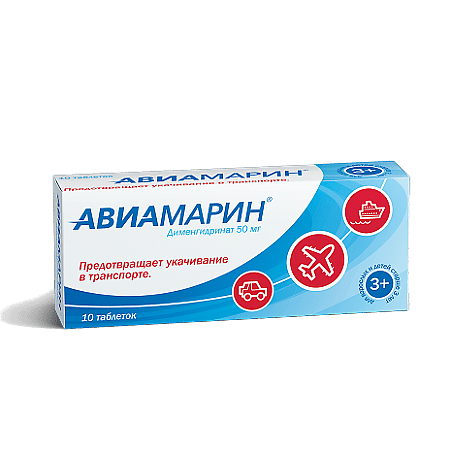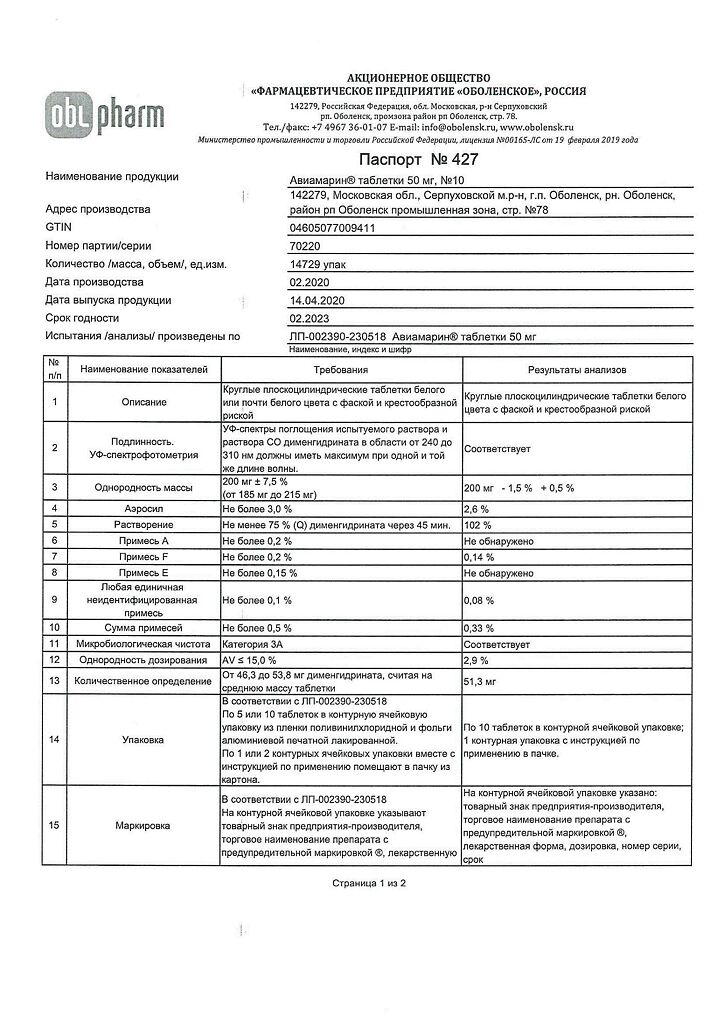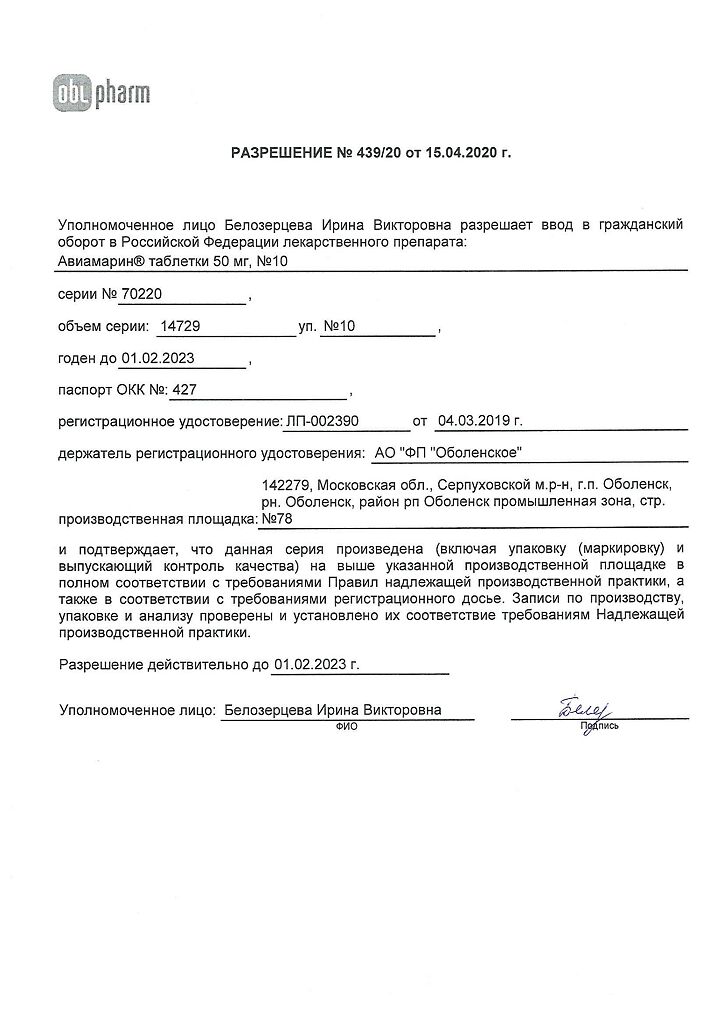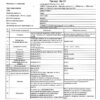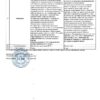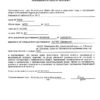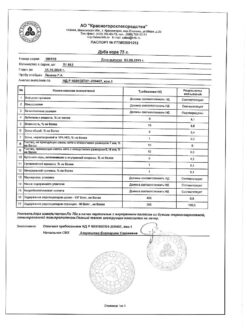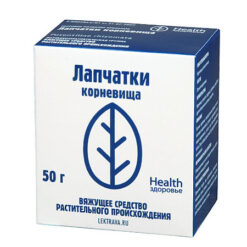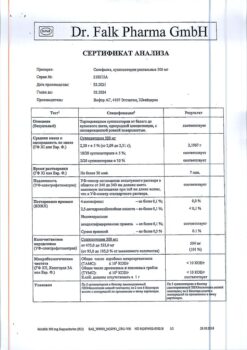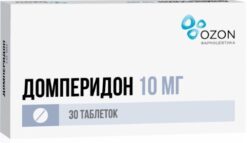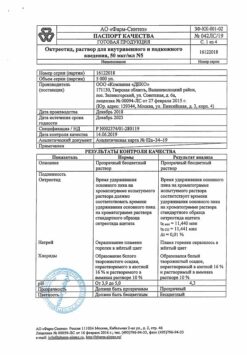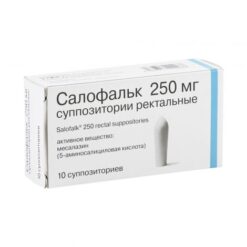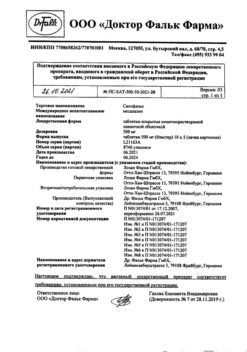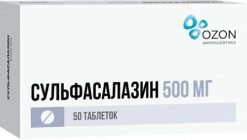No products in the cart.
Aviamarin, tablets 50 mg 10 pcs
€7.74 €6.45
Description
Pharmacotherapeutic group: H1-histamine receptor blocker
ATX code: R06AX
Pharmacological properties
Pharmacodynamics: blocks histamine H1-receptors and M-cholinoreceptors of the central nervous system. Inhibits the vestibular apparatus of the inner ear, acting primarily on the otoliths, in high doses – on the semicircular canals. It has antiemetic, anorexigenic and sedative effects, eliminates dizziness.
Pharmacokinetics: after oral administration dimenhydrinate is well absorbed and distributed among organs and tissues. The action of the drug is seen 15-30 minutes later and lasts for 3-6 hours. About 78% of dimenhydrinate is bound to blood plasma proteins. Dimenhydrinate is metabolized in the liver and is almost completely eliminated from the body with urine within 24 hours. Small amounts are excreted with breast milk. The half-life (T1/2) of dimenhydrinate is about
3.5 hours.
Indications
Indications
• Motion sickness (sea, car, air sickness).
• Prevention and treatment of symptoms of vestibular and labyrinthine disorders (dizziness, nausea, vomiting), with the exception of symptoms caused by antitumor therapy.
• Meniere’s disease.
Pharmacological effect
Pharmacological effect
Pharmacotherapeutic group: H1-histamine receptor blocker
ATX code: R06AX
Pharmacological properties
Pharmacodynamics: blocks histamine H1 receptors and M-cholinergic receptors of the central nervous system. It depresses the vestibular apparatus of the inner ear, acting primarily on the otoliths, and in high doses – on the semicircular canals. It has an antiemetic, anorexigenic, sedative effect, eliminates dizziness.
Pharmacokinetics: after oral administration, dimenhydrinate is well absorbed and distributed throughout organs and tissues. The effect of the drug appears after 15-30 minutes and lasts for 3-6 hours. About 78% of dimenhydrinate is bound to plasma proteins. Dimenhydrinate is metabolized in the liver and is almost completely excreted in the urine within 24 hours. Small amounts are excreted in breast milk. The half-life (T1/2) of dimenhydrinate is approximately
3.5 hours.
Special instructions
Special instructions
The ability to influence the reaction speed when driving a vehicle or working with other mechanisms
Given the side effects, caution should be exercised when engaging in potentially hazardous activities that require increased attention and speed of psychomotor reactions (including driving).
Active ingredient
Active ingredient
Dimenhydrinate
Composition
Composition
1 tablet contains: active ingredient: dimenhydrinate 50 mg;
excipients: microcrystalline cellulose, povidone (kollidon 30), crospovidone, mannitol, colloidal silicon dioxide (aerosil), magnesium stearate.
Pregnancy
Pregnancy
The use of the drug in the II-III period of pregnancy is possible only if the expected benefit to the mother outweighs the potential risk to the fetus. The use of the drug in the first trimester of pregnancy and during breastfeeding is contraindicated. Breastfeeding should be stopped during treatment.
Contraindications
Contraindications
Hypersensitivity to the components of the drug, epilepsy, acute exudative and vesicular dermatoses, children under 3 years of age, pregnancy (first trimester), breastfeeding period.
With caution
Convulsive syndrome, angle-closure glaucoma, prostatic hyperplasia, bronchial asthma, cardiovascular diseases, hyperthyroidism, stenosing peptic ulcer, pyloroduodenal obstruction and bladder neck obstruction.
Side Effects
Side Effects
Parameters of the frequency of side effects: very often (≥1/10), often
(≥1/100, <1/10), infrequently (≥1/1000, <1/100), rarely (≥1/10000, <1/1000), very rarely (<1/10000), unspecified frequency.
Blood and lymphatic system disorders: very rare: hemolytic anemia, agranulocytosis, neutropenia, leukopenia, thrombocytopenia or pancytopenia.
Immune system disorders: rare: anaphylactic shock.
Mental disorders: often: mood changes, anxiety, stiffness of movement; uncommon: insomnia.
Nervous system disorders: often: drowsiness; uncommon: impaired sense of balance, decreased concentration and memory impairment (more often in elderly patients), tremors, lack of coordination, confusion, hallucinations; rarely: headache, sleep disturbance, dizziness, orthostatic hypotension; very rare: paradoxical stimulation of the central nervous system (especially in children).
Visual disorders: rare: glaucoma, vision problems (dilated pupil, blurred vision or double vision).
Hearing and labyrinthine disorders: rare: tinnitus.
Heart disorders: rare: palpitations, tachycardia and hypotension.
Respiratory, thoracic and mediastinal disorders: common: nasal congestion.
Gastrointestinal disorders: often: dry mouth, constipation, diarrhea, nausea, abdominal pain.
Disorders of the liver and biliary tract: unspecified frequency: impaired liver function (cholestatic jaundice).
Skin and subcutaneous tissue disorders: rare: rash, redness.
Renal and urinary tract disorders: common: urinary disturbance (urinary retention due to anticholinergic effects).
General disorders and disorders at the injection site: rarely: edema (less commonly, Quincke’s edema).
If any of the side effects indicated in the instructions get worse, or you notice any other side effects not listed in the instructions, tell your doctor!
Interaction
Interaction
Enhances the effects of atropine, tricyclic antidepressants, catecholamines, barbiturates, alcohol, sedatives and hypnotics, neuroleptics, weakens the effect of corticosteroids, anticoagulants. Decreases response to apomorphine. Reduces the depressive effect of acetylcholine on the heart muscle. Combination with bismuth preparations, scopolamine, painkillers and psychotropic drugs increases the likelihood of visual impairment. Incompatible with ototoxic antibiotics (streptomycin, neomycin, biomycin, amikacin, kanamycin), because may mask symptoms of ototoxicity and contribute to the development of irreversible hearing loss.
Overdose
Overdose
Overdose symptoms: dry mouth, nose and throat, redness of the face, slow and difficult breathing, confusion, in children – convulsions, hallucinations. If these symptoms appear, you should immediately consult a doctor.
Treatment: gastric lavage with a suspension of activated carbon (20-30 g), administration of a saline laxative (10-15 g of sodium sulfate), symptomatic therapy, for convulsions in children – phenobarbital (5-6 mg/kg), diazepam.
Storage conditions
Storage conditions
At a temperature not exceeding 25 °C.
Keep out of the reach of children.
Shelf life
Shelf life
3 years.
Do not use after the expiration date stated on the package.
Manufacturer
Manufacturer
Alium JSC, Russia
Additional information
| Shelf life | 3 years. Do not use after the expiration date stated on the package. |
|---|---|
| Conditions of storage | At a temperature not exceeding 25 °C. Keep out of reach of children. |
| Manufacturer | Alium JSC, Russia |
| Medication form | pills |
| Brand | Alium JSC |
Related products
Buy Aviamarin, tablets 50 mg 10 pcs with delivery to USA, UK, Europe and over 120 other countries.

